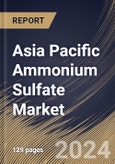Ammonium sulfate is a valuable nitrogen source for crops, with a nitrogen content of approximately 21%. Nitrogen is a key nutrient for plant growth, and ensuring adequate supply is critical for optimal yields. Farmers widely adopt it as a nitrogen fertilizer, particularly for crops with high nitrogen requirements, such as cereals and legumes. The compound's ability to acidify soil makes it an attractive choice in regions where soil pH levels need adjustment. In alkaline soils, it helps create a more favorable environment for plant nutrient uptake. Farmers adopt it strategically to address specific soil conditions, enhancing the overall productivity of their crops.
The ease of application and compatibility with various crop management practices contribute to the widespread adoption of this. It can be applied through traditional broadcasting and precision agriculture techniques, allowing farmers to tailor their fertilizer application to specific areas of their fields. Ammonium sulfate is a key ingredient in various chemical manufacturing processes. Its adoption in the production of chemicals, such as flame retardants and other industrial materials, is driven by its unique chemical properties. Industries value their contribution to synthesizing compounds crucial to producing plastics, textiles, and other materials.
As per Invest India, the pharmaceutical industry in India is anticipated to increase to $65 billion by 2024 and $130 billion by 2030. One of the largest suppliers of inexpensive vaccines is India. India is a significant exporter of pharmaceuticals, with exports to over 200+ countries. As per China.org, in 2021, the combined business revenue of China's pharmaceutical companies increased by 18.7 percent annually, the greatest growth rate in five years. Therefore, due to the above-mentioned factors, the market will grow significantly in this region.
The China market dominated the Asia Pacific Ammonium Sulfate Market, By Country in 2022, and would continue to be a dominant market till 2030; thereby, achieving a market value of $699.4 million by 2030. The India market is experiencing a CAGR of 6% during (2023 - 2030). Additionally, The Thailand market would showcase a CAGR of 8.4% during (2023 - 2030).
Based on Product, the market is segmented into Solid, and Liquid. Based on Application, the market is segmented into Fertilizers, Food & Feed Additives, Pharmaceuticals, Water Treatment, and Others. Based on countries, the market is segmented into China, Japan, India, South Korea, Thailand, Australia, and Rest of Asia Pacific.
List of Key Companies Profiled
- BASF SE
- Evonik Industries AG (RAG-Stiftung)
- LANXESS AG
- SABIC (Saudi Arabian Oil Company)
- Sumitomo Chemical Co. Ltd.
- Honeywell International, Inc.
- Helm AG
- ArcelorMittal S.A.
- Akzo Nobel N.V.
- Domo Chemicals GmbH
Market Report Segmentation
By Product (Volume, Kilo Tonnes, USD Billion, 2019-2030)- Solid
- Liquid
- Fertilizers
- Food & Feed Additives
- Pharmaceuticals
- Water Treatment
- Others
- China
- Japan
- India
- South Korea
- Singapore
- Malaysia
- Rest of Asia Pacific
Table of Contents
Companies Mentioned
- BASF SE
- Evonik Industries AG (RAG-Stiftung)
- LANXESS AG
- SABIC (Saudi Arabian Oil Company)
- Sumitomo Chemical Co. Ltd.
- Honeywell International, Inc.
- Helm AG
- ArcelorMittal S.A.
- Akzo Nobel N.V.
- Domo Chemicals GmbH








